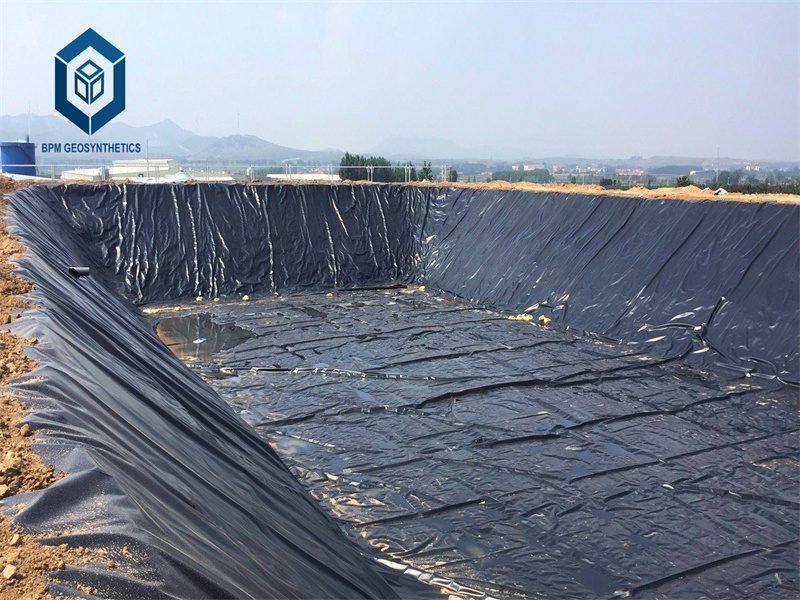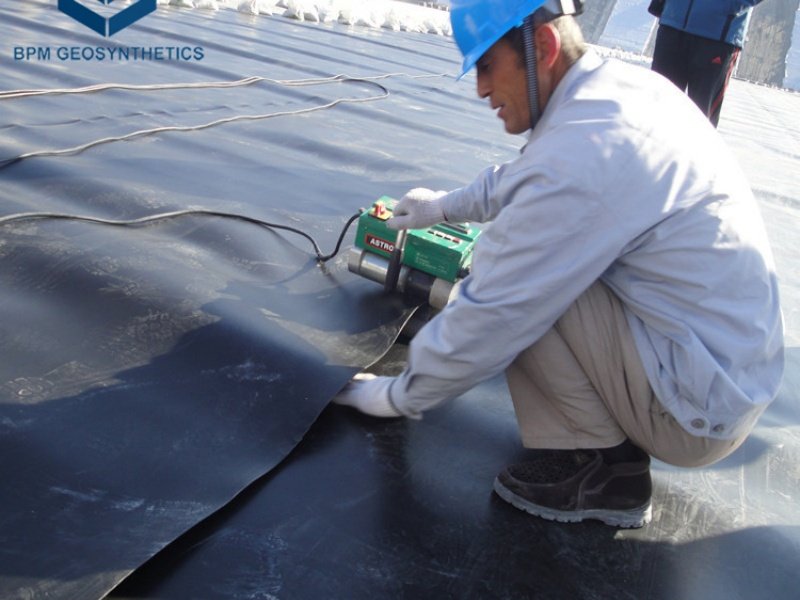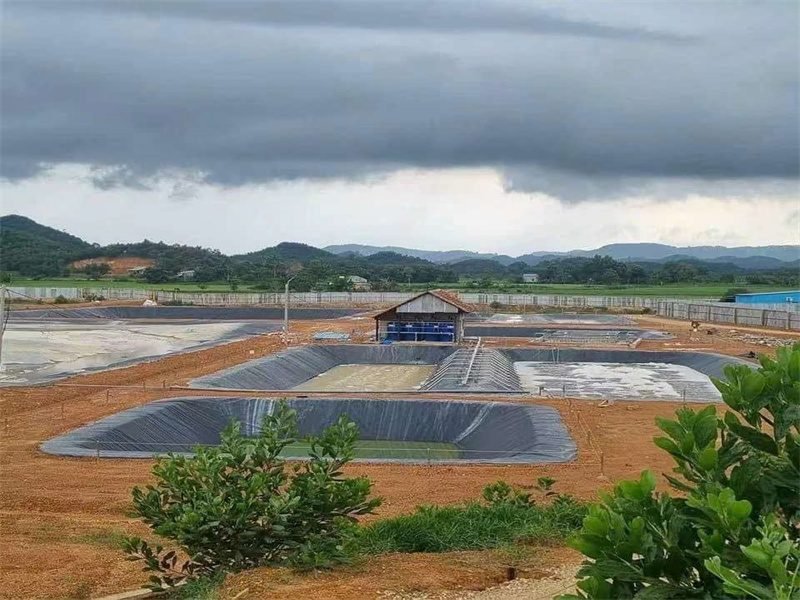There are many kinds cost-effective and high value geomembrane liners are accessible in the market, with pricing influenced by various factors. While a LLDPE Geomembrane liner may offer affordability, it lacks the strength and durability of more reinforced options like HDPE Geomembrane liners. Additionally, project size plays a significant role in determining cost; smaller projects such as fish farm ponds are less expensive compared to larger endeavors like mining lining projects.
No matter your usage budget, there are a wide range of options when it comes to initial investment, and long term maintenance costs. As the leading geomembrane liner manufacturer and supplier, BPM Geosynthetics offers various geomembrane liner including HDPE, LLDPE, textured, composite, PVC and EPDM geomembrane liner for a wide range of applications. In this blog, let us delve into the following topics.
- What Is Geomembrane Liner?
- What Are Benefits of Geomembrane Liner?
- What Are Geomembrane Liner Used For?
- How Much Does Geomembrane Liner Cost?
1. What Is Geomembrane Liner?
A geomembrane liner is a synthetic membrane or barrier with very low permeability used in conjunction with geotechnical engineering materials to control the migration of fluids (liquids or gases) in human-made projects, structures, or systems.
Geomembrane liners are impermeable membranes that work together with rocks or soil to prevent the movement of fluids in man-made structures. These liners are typically made of synthetic polymers and are available in sheets ranging from 0.5 to 3.0 mm (20 to 120 mil) in thickness. Common materials used for geomembrane liners include EPDM (Ethylene Propylene Diene Monomer), Linear Low-Density Polyethylene (LLDPE), High-Density Polyethylene (HDPE), Polyvinyl Chloride (PVC), and Polypropylene (PP). While geomembrane liners are primarily thin continuous polymeric sheets, they can also be made by impregnating geotextiles with asphalt, elastomers, or polymer sprays, or as multilayered bitumen geocomposites. Continuous polymer sheet geomembranes are the most commonly used type. These liners effectively block the movement of fluids, preventing the spread of contaminants, and can be used in combination with soil liners or permeable geotextiles to create composite lining systems that offer additional security.
Among the various types, HDPE geomembrane liners are often preferred for lining projects that require high liner strength. HDPE liners are resistant to many solvents and are the most widely used geomembrane liners worldwide. While they may be less flexible than LLDPE, HDPE liners provide higher specific strength and can withstand higher temperatures. Additionally, their ultraviolet resistance properties make them a cost-effective choice.
BPM geomembrane products are manufactured using durable virgin materials that can have an expected lifespan of hundreds of years. They are resistant to chemicals and wear, ensuring that the integrity of the geomembrane liner remains unaffected by the passage of time and corrosion. Each type of geomembrane liner material has specific characteristics that impact installation procedures, lifespan, and performance. BPM Geosynthetics offers a variety of materials tailored to the specific needs of your project.

2. What Are Benefits of Geomembrane Liner?
Geomembrane liner offers effective water resistance, durability, versatility, chemical and UV resistance, cold temperature performance, affordability, rapid installation, and a long lifespan when properly covered. These benefits make them valuable for a wide range of geotechnical engineering applications.
2.1 Effective Water Resistance
Geomembrane liners have very low permeability, offering excellent water resistance. They effectively prevent the migration of liquids or gases, ensuring reliable containment of fluids in various applications such as reservoirs, ponds, or wastewater treatment facilities.
2.2 Durability and Longevity
Geomembrane liners are designed to be highly durable and long-lasting. They are resistant to chemical degradation, UV radiation, and mechanical stress, allowing them to maintain their performance and integrity over extended periods. With proper installation and maintenance, geomembrane liners can provide reliable performance for many years.
2.3 Versatility and Adaptability
Geomembrane liners are available in various materials, thicknesses, and strengths, making them versatile for different project requirements. They can be customized to suit specific applications, such as landfill liners, mining operations, or agricultural irrigation systems. This adaptability ensures they can be effectively used in diverse geotechnical engineering projects.
2.4 Excellent Chemical and UV Resistance
Geomembrane liners exhibit excellent resistance to chemicals, including acids, alkalis, and other corrosive substances. They can withstand exposure to a wide range of chemicals without deteriorating, making them suitable for applications where chemical containment is crucial. Additionally, geomembrane liners have UV resistance, protecting them from degradation caused by sunlight exposure.
2.5 Performs Well in Cold Temperatures
Geomembrane liners maintain their flexibility and performance even in cold temperatures. They do not become brittle or lose their effectiveness when exposed to freezing conditions, making them suitable for applications in colder climates.
2.6 Relatively Affordable
Compared to alternative containment methods, geomembrane liners can be a cost-effective solution. While the initial investment may vary depending on the specific project, geomembrane liners’ long-term durability and reduced maintenance needs can lead to cost savings over their lifespan.
2.7 Rapid Installation
Geomembrane liners can be installed quickly and efficiently, saving time and labor costs. They are lightweight, flexible, and can be prefabricated into large panels or rolls, facilitating easy transportation and installation. This rapid installation process allows for faster project completion.
2.8 Long Life span
When properly covered and maintained, geomembrane liners can have a lifespan of up to 70 years. This longevity ensures long-term performance and reduces the need for frequent replacements, contributing to cost savings and environmental sustainability.
3. What Are Geomembrane Liner Used For?
Geomembrane liner is widely used for many applications. Their versatility, durability, and ability to prevent fluid migration make them valuable in a wide range of industries and projects.
3.1 Secondary Containment
Geomembrane liners are used for the containment of hazardous materials, providing primary and secondary containment systems to prevent pollutants from spilling or leaking into the soil and groundwater. They are commonly used in facilities such as refineries, airports, and chemical storage areas.
3.2 Farm Pond Liners
Geomembrane liners are utilized in the construction of farm ponds to prevent seepage and retain water. They help enhance water storage capacity, prevent soil erosion, and ensure efficient irrigation for agricultural purposes.
3.3 Waste Landfills
Geomembrane liners play a critical role in landfill construction to prevent waste leakage and protect the environment. They are used for lining both primary and secondary solid waste landfills, acting as a barrier to prevent contaminants from reaching the underlying soil and groundwater. Geomembrane liners can also be used as alternative daily covers and for rainwater diversion in landfills.
3.4 Roads and Highways
Geomembrane liners can be employed in road and highway construction as a waterproofing barrier beneath asphalt surfaces. They help prevent water infiltration, reduce the risk of damage to the road structure, and minimize pollution from de-icing salt used in winter road maintenance.
3.5 Waste Liquid Containment
Geomembrane liners are used in applications involving the containment of waste liquids, including radioactive or hazardous waste. They provide a reliable barrier that prevents the migration of these liquids into the surrounding environment.
3.6 Mining Projects
Geomembrane liners are utilized in mining operations for various purposes. They can be used for lining tailings ponds to prevent the release of potentially harmful mine tailings into the environment. Geomembrane liners are also used in heap leach pads, evaporation ponds, and other containment structures associated with mining activities.
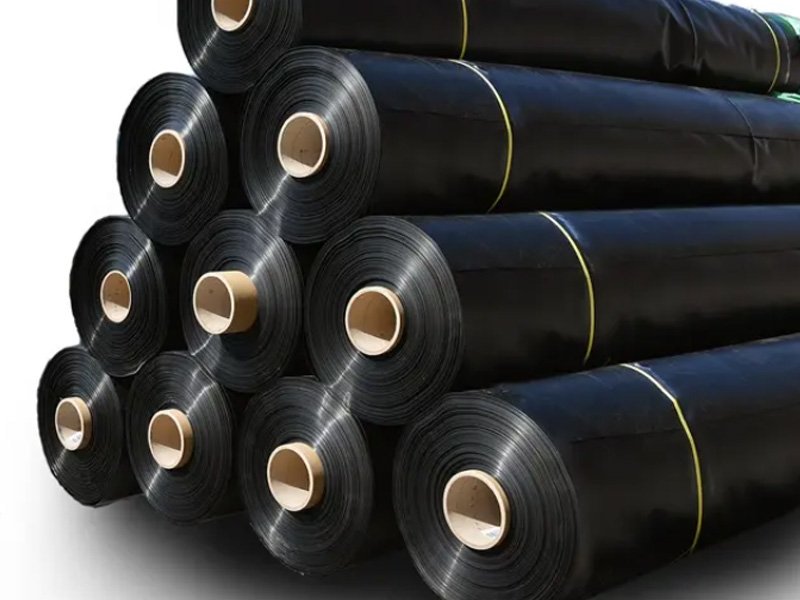
4 .How Much Does Geomembrane Liner Cost?
When determining the cost of a geomembrane liner, it is vital to consider both the initial investment and the long-term maintenance costs. Evaluating the costs over the liner’s lifespan and assessing the return on investment it provides will help uncover the real cost. Choosing a reliable supplier with competitive prices and stable quality is essential for a cost-effective solution.
4.1 Plan Your Project
When considering the cost of a geomembrane liner, it is important to take into account both the initial investment and the long-term maintenance costs associated with the project. With a wide range of geomembrane liners available in the market, choosing the best fit for your specific application is crucial to ensure a smooth construction process.
4.2 Lifespan Cost and ROI
It is essential to understand that a low initial cost does not necessarily mean a lower overall cost. To uncover the real cost of a geomembrane liner, it is necessary to evaluate the costs over the product’s entire lifespan. This includes considering the average lifespan of the liner and assessing the return on investment it provides.
4.3 Material Costs
The unit price of material varies depending on the type geomembrane liners and size of the project. HDPE cost is higher than LDPE, LLDPE and PVC or EPDM. It is important to consider that adding a geotextile layer to increase puncture strength can contribute to the overall installation price. To ensure cost-effectiveness, it is crucial to choose a reliable supplier that offers stable quality and competitive prices for geomembrane liners. The cost of the geomembrane liner on the market was about US$1200 to $1800 per tons.
4.3 Installation Cost
The installation process of a geomembrane liner plays a crucial role in the overall quality of the project and the performance of the liner itself. It is important to employ skilled labor during the installation to avoid any damage to the liner. Improper installation techniques can lead to issues such as liner stress and improper heat-welding, which can compromise the effectiveness of the liner.
4.5 Maintenance Costs
Regular maintenance is essential to ensure the optimal performance and extended service life of a geomembrane liner. The specific maintenance requirements can vary depending on the type of geomembrane used. For example, HDPE geomembranes may be susceptible to problems like environmental stress cracking, which can impact their effectiveness and durability.
Proper maintenance practices, such as routine inspections, cleaning, and repairs, should be implemented to address any potential issues and ensure the longevity of the liner. It is important to follow the manufacturer’s guidelines for maintenance to maximize the performance and lifespan of the geomembrane liner. Electrical leak location surveys for geomembrane liners typically cost US$0.4 to US$0.6 per square meters.
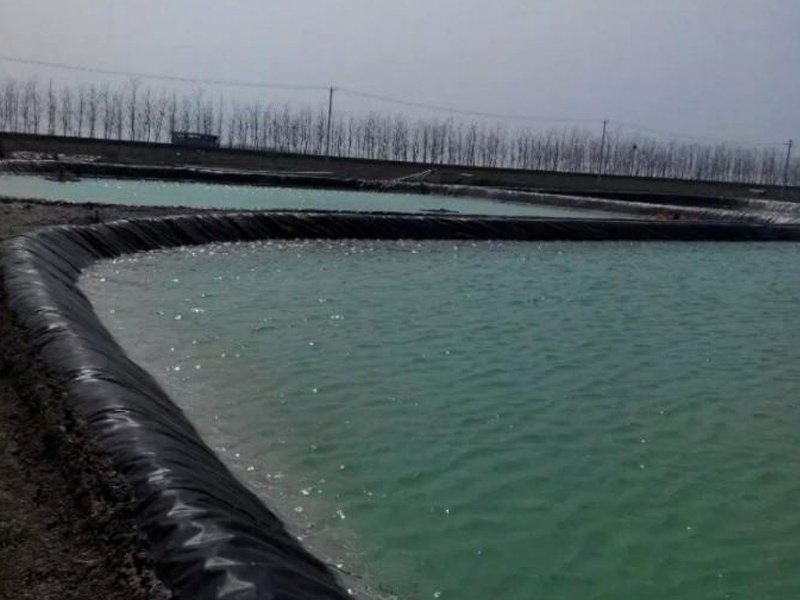
5. Conclusion
Geomembrane liners play a crucial role in preventing fluid movement in man-made structures, working in conjunction with rocks or soil. When selecting a geomembrane liner for your specific project, it is important to make decisions based on more than just the initial cost. Taking into account all relevant factors will help avoid unexpected costs and maintain control over the project. It is essential to conduct thorough research and carefully consider various options to find a product that strikes the right balance between performance and budgetary requirements.
Determining the cost of a geomembrane liner requires consideration of both the initial investment and the long-term maintenance costs. Evaluating the costs over the liner’s lifespan and assessing the return on investment it offers will provide a more accurate understanding of the true cost. Additionally, choosing a reliable supplier that offers competitive prices and maintains stable quality is crucial for achieving a cost-effective solution.
By taking a comprehensive approach to evaluating geomembrane liners, considering factors beyond just the initial cost, and prioritizing quality and long-term value, you can make informed decisions that align with your project goals. This will help ensure the successful implementation of the geomembrane liner while managing costs effectively.

